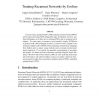1629 search results - page 306 / 326 » Evolutionary Multi-agent Systems |
ALIFE
2000
13 years 7 months ago
2000
The evolution of simulated robots with three different architectures is studied in this article. We compare a nonmodular feed-forward network, a hardwired modular, and a duplicatio...
TPDS
1998
13 years 7 months ago
1998
—A massive volume of biological sequence data is available in over 36 different databases worldwide, including the sequence data generated by the Human Genome project. These data...
NAR
2007
13 years 7 months ago
2007
The GeneTrees phylogenomics system pursues comparative genomic analyses from the perspective of gene phylogenies for individual genes. The GeneTrees project has the goal of provid...
NCA
2007
IEEE
13 years 7 months ago
2007
IEEE
One of the key success factors behind the human species is the ability to think, plan and pursue goals. Apart from wisdom and tacit knowledge, experience and awareness of the phys...
NECO
2007
13 years 7 months ago
2007
In recent years, gradient-based LSTM recurrent neural networks (RNNs) solved many previously RNN-unlearnable tasks. Sometimes, however, gradient information is of little use for t...

